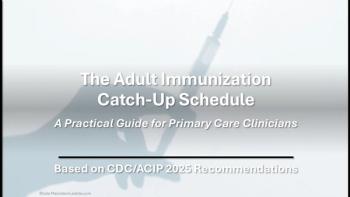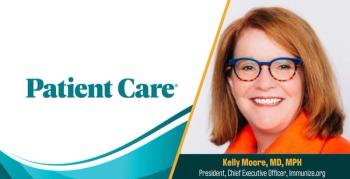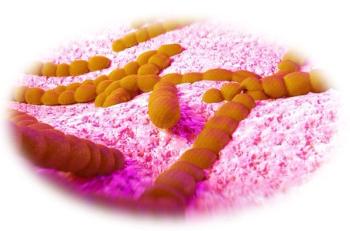
The Journal of Respiratory Diseases
- The Journal of Respiratory Diseases Vol 5 No 10
- Volume 5
- Issue 10
Clearing up chronic rhinosinusitis: Practical steps to take
Abstract: Chronic rhinosinusitis can be caused or aggravated by a number of factors, including bacterial, viral, and fungal infections; asthma; allergies; and obstruction caused by nasal polyps or a deviated nasal septum. The diagnosis can usually be established clinically. Imaging studies are not routinely necessary, but a CT scan of the sinuses should be obtained if the patient has significant ocular or orbital symptoms or if sinus surgery is planned. Treatment consists of antibiotics, with consideration of a change in the regimen if the patient has already received a full course of a first-line agent. The course of treatment may need to extend to 4 weeks. Also consider adjunctive therapy, such as intranasal corticosteroids and decongestants. Patients who have allergic rhinitis may also benefit from an antihistamine and/or a leukotriene modifier. Sinus surgery is reserved for patients who do not respond to medical therapy. (J Respir Dis. 2005;26(10):415-422)
Rhinosinusitis (infection or inflammation of the mucous membranes lining the paranasal sinuses) is one of the most common health problems in our country.1-4 Each year, it affects about 37 million Americans, costs nearly $6 billion, and accounts for nearly 1 million lost days from work.5
Rhinosinusitis can be acute, chronic, or recurrent. The acute form lasts for 3 weeks or less.6 When 4 or more distinct episodes of acute rhinosinusitis occur within a year, the patient is considered to have recurrent rhinosinusitis. Rhinosinusitis is considered to be chronic when, following the patient's treatment for acute rhinosinusitis, either bothersome symptoms persist for 12 weeks or CT changes persist for 4 weeks. The chronic form of rhinosinusitis is the most common, affecting about 32 million Americans per year.6 It typically lasts for weeks, but it can persist for months or years.6
In this article, I will focus on diagnosis and management of chronic rhinosinusitis. An accompanying Patient Education Guide (page 452) will provide your patients with some answers to common questions about chronic rhinosinusitis.
CAUSES
Most cases of rhinosinusitis start as a viral or bacterial upper respiratory tract infection (URTI). About 10% of cases of maxillary rhinosinusitis have a dental origin.7 The most common bacterial causes are Streptococcus pneumoniae, Haemophilus influenzae,Moraxella catarrhalis, Streptococcus pyogenes, and Streptococcus viridans.8 Anaerobic bacte-ria account for only about 7% of acute infections. The most common anaerobic bacteria that cause chronic rhinosinusitis are the anaerobic streptococci, Bacteroides species, and Fusobacterium.
Infection typically begins in the mucosal layer of the sinus, then spreads into the glandular cells and into the deeper layers of the sinus cavities.9 Stasis of trapped respiratory secretions can lead to bacterial overgrowth and chronic disease (see "Sinus function: A review of the basics").10-12
Rhinosinusitis can also be related to fungal infection. Invasive fungal rhinosinusitis is most common in persons who are diabetic or immunocompromised. A distinct entity--allergic fungal sinusitis (AFS)--occurs in immunocompetent patients who have localized immunologic hypersensitivity reactions to fungal colonization of the sinuses.3 AFS is usually caused by Bipolaris spicifera or Aspergillus,Curvularia,Helminthosporium,Alternaria, or Fusarium species.3
Chronic rhinosinusitis can have a noninfectious origin. Physical obstruction, such as that caused by a deviated septum or nasal polyps, can cause entrapment and pooling of respiratory secretions. Diseases or conditions that cause thickening of respiratory mucus, such as cystic fibrosis, can delay transit of mucus through the sinuses. Asthma and allergies to airborne irritants, such as dust, mold, pollen, and pollutants, increase inflammation in the nasal passages and sinuses.
PATIENT EVALUATION
The signs and symptoms of rhinosinusitis often resemble those of allergy or a viral URTI, except for their duration (Table 1). The chief symptom of URTI is nasal congestion without persistent or worsening head congestion, headache, facial pain, or fatigue. Symptoms of URTI, unlike those of rhinosinusitis, peak at days 3 to 5 and resolve within 7 to 10 days. Differentiating rhinosinusitis from a viral URTI helps avoid unnecessary treatment with antibiotics.
The location of sinus pain can vary, depending on the sinuses affected. Pain in the forehead suggests frontal sinus involvement, while aching in the upper jaw and teeth can be caused by infection in the maxillary sinuses. Patients with inflammation in the ethmoidal sinuses may have periorbital swelling, nasal tenderness, a stuffy nose, and loss of ability to smell.
Earaches, neck pain, and pain at the top of the head are consistent with sphenoidal infection. However, the areas of pain are not always clearly defined, especially if multiple sinus cavities are inflamed. Signs of inflammation include purulent drainage, polyps, polypoid changes, and mucosal abnormalities in the middle meatus. The diagnosis of chronic rhinosinusitis can be based on the patient's history and symptoms. The presence of purulent secretions is one of the strongest signs of rhinosinusitis. On examination, purulent drainage may be evident as anterior rhinorrhea or posterior pharyngeal drainage with associated symptoms of sore throat and cough. Nasal discharge is thick and yellow to yellowish green when it is associated with bacterial infection; it is thin and clear when associated with allergies or viral infection.
Examine the patient's nose for a deviated nasal septum, nasal polyps, and epistaxis. Foreign bodies and tumors may mimic symptoms of rhinosinusitis, but they usually cause unilateral symptoms. Check the ears for signs of associated otitis media, and auscultate the chest for wheezing, which may suggest asthma.
Cultures are notoriously unreliable for determining the cause of rhinosinusitis, because of nasal contamination. The exception is when specimens for culture are obtained via sterile antral puncture, which is both difficult and impractical to perform in a clinical setting.13,14 A nasal smear, however, can be useful: the presence or absence of polymorphonuclear cells suggests bacterial or viral infection, respectively. When rhinosinusitis is related to allergy, the smear typically contains eosinophils.
Examination of the sinus contents by endoscopy or rhinoscopy yields clues to fungal involvement. In patients with AFS, the sinus contains allergic mucin, a thick gray-brown secretion containing Charcot-Leyden crystals and fungal elements.3 Patients with fungal rhinosinusitis typically have no evidence of diabetes, immunosuppression, or invasive fungal disease, but their sinus contents contain allergic mucin and fungal elements.
Although some physicians recommend performing imaging studies if the results of the initial workup do not clearly support the diagnosis of chronic rhinosinusitis, I do not find them to be very helpful or cost-effective when done so early in the workup.15
MANAGEMENT
Antibiotics
By the time rhinosinusitis is considered to be chronic, the mucociliary system has been significantly damaged and additional treatment becomes important. Remember that most patients will have already received several weeks of therapy with an antibiotic, such as amoxicillin, amoxicillin-clavulanate, or azithromycin.16 Because the antibiotic the patient has received has not controlled the symptoms, consider changing to a different antibiotic.
A general rule of thumb is to treat with a first-line antibiotic for 10 to 20 days. If that is ineffective, try a second-line antibiotic for another 20 days or longer (Table 2).3,17 In the absence of culture results, the choice of which first- or second-line antibiotic to prescribe is typically empiric, with some consideration given to the prevailing pathogens and to whether the infection was community-acquired or hospital-acquired. Because of the need to achieve a minimal inhibitory concentration (MIC), the dosage generally needs to be relatively high.18,19
If a patient is responding poorly to the first- or second-line antibiotic, consider prescribing an agent that is effective against anaerobic organisms. Clindamycin and metronidazole are common choices, administered at a dosage required to reach an MIC in the sinus secretions. The course of treatment may need to be extended to 4 weeks.
Supportive treatment
Patients with chronic rhinosinusitis can benefit from supportive therapies, including decongestants, corticosteroid nasal sprays, and systemic corticosteroids. Local decongestants may occasionally be helpful, with one caveat: patients should limit their use of topical decongestants to a period of 2 or 3 days. Extended use introduces the risk of a rebound swelling effect, or rhinitis medicamentosa. Because this complication can be difficult to recognize and treat, it is best avoided altogether.
Systemic decongestants pose no risk of rhinitis medicamentosa, but they are probably somewhat less effective than topical decongestants. The potential for systemic decongestants to cause hypertension in otherwise healthy persons is minimal.20
Corticosteroid nasal sprays are helpful for controlling allergic rhinitis and may also be useful for rhinosinusitis (Table 3).21 Available preparations have little or no systemic absorption and are safe when used for only 4 to 8 weeks. Patients should realize, however, that these sprays take 1 to 2 days to produce a significant effect.
For particularly severe cases of chronic rhinosinusitis, a short course of high-dose systemic corticosteroids can provide significant relief. The effectiveness of systemic corticosteroids for decreasing inflammation outweighs any risk that may be associated with administering these drugs in the setting of an infection.
Patients with known underlying allergic rhinitis may benefit from an antihistamine. Cetirizine, cetirizine/pseudoephedrine, fexofenadine, and fexofenadine/pseudoephedrine are usually effective. Cromolyn nasal spray may also be helpful, but its effectiveness is unpredictable. Leukotriene inhibitors, given alone or in combination with an antihistamine/ decongestant, have recently been reported to alleviate symptoms of allergic rhinitis and may also help manage the symptoms of chronic rhinosinusitis.
Nonpharmacologic measures that may help the patient feel more comfortable include the use of saline nasal sprays as often as necessary and the application of gentle heat over the inflamed area. Inhaling steam from a vaporizer or bowl of hot water may also temporarily alleviate sinus pain, pressure, and congestion.
Surgical intervention
Referral to a specialist for functional endoscopic sinus surgery (FESS) is prudent in the following circumstances:
•The patient's condition does not improve after 4 to 6 weeks of antibiotics and adjunctive treatment.
•Rhinosinusitis recurs after the patient initially responds to antibiotics. There is no set number of infections per year that mandates surgery; in the absence of an impending complication, the decision often depends on the patient's tolerance and schedule (including number of days missed from work or school).
•The patient has AFS. Surgery is usually indicated to remove the inspissated allergic mucin and polyps, and it is followed by systemic and intranasal corticosteroids to decrease the inflammatory response.
CT scans are an important precursor to surgery. Scans done in the coronal plane and without contrast are standard. The results typically show opacification of the involved sinuses (Figure 2).
FESS allows the surgeon to improve sinus drainage and resolve obstructions or anatomic abnormalities under direct visualization. It is less invasive than traditional surgery and poses few complications. Only rarely is the sinus mucosa irreversibly diseased or damaged, and patients with chronic rhinosinusitis usually respond very well to FESS.
COMPLICATIONS
Chronic rhinosinusitis, especially when there is involvement of the frontal sinuses, places the patient at risk for meningitis as well as epidural or subdural brain abscess.22 These complications can be masked by antibiotic treatment, so it is particularly important to maintain a high index of suspicion and to monitor patients closely.23
Orbital complications, including cellulitis, subperiosteal abscess, and orbital abscess, may also occur, especially after infection in the ethmoidal sinuses. These infections are more common in children, for unknown reasons.24
Any patient in whom there is evidence of complications, such as significant ocular or orbital symptoms, is a candidate for CT of the sinuses. A change in sensorium is an indication for emergency MRI with contrast.
PREVENTIVE MEASURES
There are several steps patients can take to protect themselves against rhinosinusitis. Avoidance of airborne irritants, such as cigarette smoke and other pollutants, can help. Patients who have known or suspected allergies to mold, pollen, dust, or other irritants should consult an allergist, who can recommend treatment to reduce or limit allergy symptoms. Excessive alcohol consumption can cause swelling of nasal or mucous membranes in some patients.
Chlorine can irritate the lining of the nose and sinuses, so patients might want to avoid swimming in treated pools. Patients who need to travel by air might find the trip more comfortable if they use decongestants and saline nasal sprays before and during the flight. Environmental controls--humidifiers, air conditioners, and filters--can also help keep air clean and at a stable temperature, which is better for the sinuses.
Although acute rhinosinusitis cannot always be prevented, it can be managed successfully and relatively simply. A program of close observation, medical treatment, supportive measures, and environmental modification can help patients recover quickly and avoid recurrence or complications.
References:
REFERENCES
1. Hilding AC. The role of the respiratory mucosa in health and disease.
Minn Med.
1967; 50:915-919.
2. Tomasi TB Jr, Tan EM, Solomon A, Prendergast RA. Characteristics of an immune system common to certain external secretions.
J Exp Med.
1965;121:101-124.
3. Georgitis JW. Sinusitis: a significant unappreciated disorder. Available at: www. grayenvironmental.com. Accessed May 2, 2005.
4. Green RN. The role of viral infection in the etiology and pathogenesis of chronic bronchitis and emphysema: the consideration of a naturally occurring animal model.
Yale J Biol Med.
1968; 40: 461-476.
5. National Institute of Allergy and Infectious Diseases. Sinusitis. Available at: www.niaid. nih.gov/factsheets/sinusitis.htm. Accessed April 25, 2005.
6. Ray NF, Baraniuk JN, Thamer M, et al. Healthcare expenditures for sinusitis in 1996: contributions of asthma, rhinitis, and other airway disorders.
J Allergy Clin Immunol.
1999; 103(3 pt 1):408-414.
7. Waldman RH. Sinusitis. In: Waldman RH, Kluge RM, eds.
Infectious Diseases.
New York: Medical Examination Publishing; 1984.
8. Brook I. Microbiology and antimicrobial management of sinusitis.
J Laryngol Otol.
2005; 119: 251-258.
9. Lundberg C. Bacterial invasion of the sinus mucosa.
Acta Otorhinolaryngol Belg.
1983; 37: 589-594.
10. Gorback SL, Bartlett JG, Tally FP.
Biology of Anaerobes.
Kalamazoo, Mich: Upjohn Company; 1981.
11. Aly R, Maibach HI, Strauss WG, Shinefield HR. Effects of systemic antibiotic on nasal bacterial ecology in man.
Appl Microbiol.
1970; 20: 240-244.
12. Piccirillo JF. Clinical practice: Acute bacterial sinusitis.
N Engl J Med.
2004;351:902-910.
13. Brook I. Aerobic and anaerobic bacterial flora of normal maxillary sinuses.
Laryngoscope.
1981;91:372-376.
14. Daley CL, Sande M. The runny nose. Infection of the paranasal sinuses.
Infect Dis Clin North Am.
1988;2:131-147.
15. Gwaltney JM Jr, Phillips CD, Miller RD, Riker DK. Computed tomographic study of the common cold.
N Engl J Med.
1994; 330: 25-30.
16. Malow JB, Creticos CM. Nonsurgical treatment of sinusitis.
Otolaryngol Clin North Am.
1989;22:809-818.
17. Spector SL, Bernstein IL, Li JT, et al. Parameters for the diagnosis and management of sinusitis.
Ann Allergy Asthma Immunol.
1998; 102(6 pt 2):S107-S144.
18. Buchanan P, Roos K, Tellier G, et al. Bacteriological efficacy of 5-day therapy with telithromycin in acute maxillary sinusitis.
Int J Antimicrob Agents.
2005;25:237-246.
19. Mabry RL. Pharmacotherapy with immunotherapy for the treatment of otolaryngic allergy.
Ear Nose Throat J.
1990;69:63-71.
20. Storms WW. Clinical experiences with triamcinolone in rhinitis.
J Respir Dis.
1991; 12 (suppl): S34-S39.
21. Blitzer A, Carmel P. Intracranial complications of disease of the paranasal sinuses. In: Blitzer A, Lawson W, Friedman WH, eds.
Surgery of the Paranasal Sinuses.
Philadelphia: Saunders; 1985: 328-337.
22. Chalstrey S, Pfleiderer AG, Moffat DA. Persisting incidence and mortality of sinogenic cerebral abscess: a continuing reflection of late clinical diagnosis.
J R Soc Med.
1991;84:193-195.
23. Goodwin WJ Jr, Weinshall M, Chandler JR. The role of high resolution computerized tomography and standardized ultrasound in the evaluation of orbital cellulitis.
Laryngoscope.
1982; 92: 728-731.
24. Fearon B, Edmonds B, Bird R. Orbital-facial complications of sinusitis in children.
Laryngoscope.
1979;89(6 pt 1):947-953.
Articles in this issue
about 20 years ago
Diagnostic Puzzlers: A case of new-onset wheezing during pregnancyabout 20 years ago
The keys to diagnosing interstitial lung disease: Part 2about 20 years ago
Clinical Update: Influenza 2005-2006: Are you prepared?about 20 years ago
Why all patients with asthma do not require controller therapyabout 20 years ago
Why patients with asthma should be given a trial of controller therapyabout 20 years ago
Managing asthma: Options for assessing severity and controlabout 20 years ago
Asthma therapy: Changing perspectivesabout 20 years ago
Using controller therapy in the management of asthmaNewsletter
Enhance your clinical practice with the Patient Care newsletter, offering the latest evidence-based guidelines, diagnostic insights, and treatment strategies for primary care physicians.


























































































































































































































































































